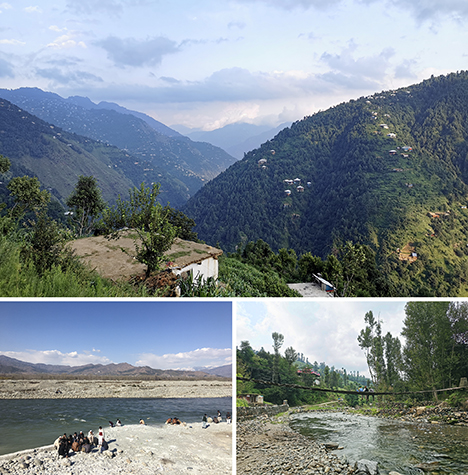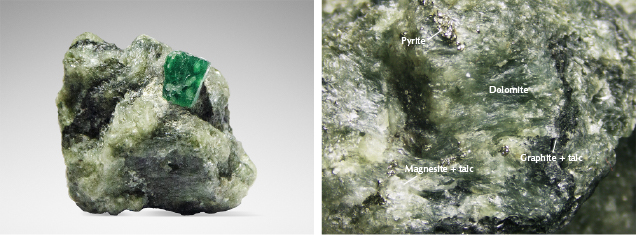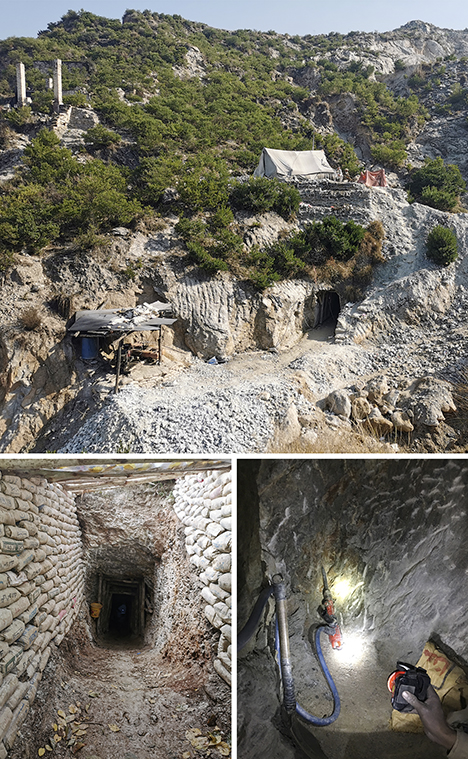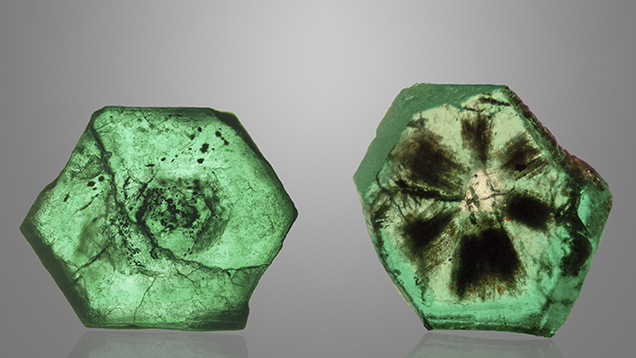Inclusion and Trace Element Characteristics of Emeralds from Swat Valley, Pakistan
Hongshu Guo, Xiaoyan Yu, Yuyu Zheng, Zhulin Sun, and Miro Fei-Yeung Ng

Figure 1. Swat emeralds are internationally renowned for their bright colors, even in small stones such as these, ranging from 0.3 to 0.8 ct. Photo by Hongshu Guo.
ABSTRACT
"Swat Valley has become an important source of emeralds, including recently discovered trapiche-type crystals. In this study, emerald samples from Swat were examined by standard gemological testing, UV-Vis-NIR, FTIR, Raman analysis, EDXRF, and LA-ICP-MS. The study found three-phase hexagonal inclusions consisting of water, gaseous carbon dioxide and nitrogen, and a magnesite crystal. The gaseous mixture in two-phase inclusions is characteristic in both trapiche-type (CO2 + N2) and non-trapiche samples (CO2 + N2 + CH4). Mineral inclusions of hematite, magnetite, rutile, graphite, and siderite are reported for the first time. Regular non-trapiche-type Swat emeralds contain high chromium (avg. 7471 ppmw), alkali metal (avg. 21040 ppmw), magnesium (avg. 34263 ppmw), and iron (avg. 9265 ppmw), as well as scandium (avg. 633 ppmw). Infrared spectra show that the absorption of type II H2O is stronger than that of type I H2O. Logarithm plots of trace elements appear to be diagnostic. Based on Raman spectroscopy, the trapiche-type emeralds’ colorless core, light green hexagonal growth zone area, and green rim are emerald, while the six black arms are a mixture of hematite and graphite.
INTRODUCTION
Pakistan’s production of emeralds has been increasing in recent years, and reserves are estimated at almost 70 million carats (Jamal-ud-Din, 2014; Makki and Ali, 2019). Swat Valley is known for small stones with saturated color (figure 1). Mineralogical curiosities include three-phase fluid inclusions (Gübelin, 1982) and newly discovered trapiche-type emeralds (Khan, 2018). Photomicrographs of three-phase inclusions in Swat emeralds are provided for the first time in this study.
The history and geology of the Swat deposit were comprehensively reported by Arif et al. (2011) and Giuliani et al. (2019) and are summarized here. However, a detailed study of the inclusions and trace elements of Swat emeralds has not been published despite analytical and geological advances (Bowersox and Anwar, 1989; Gao et al., 2019).
Therefore, we present results from a detailed study of gemological properties, inclusions, spectroscopy, and chemical composition to characterize the emeralds from Swat Valley. Our findings provide insights that can be used for understanding the genesis of the emeralds in this deposit while shedding light on the geographic origin determination of emerald.
HISTORY AND GEOLOGY
Pakistan’s emeralds have been found in four deposits, including Swat Valley in Swat District, Gandao in Mohmand Agency, Barang in Bajaur Agency, and Khaltaro in Gilgit-Baltistan (Khan, 2018). The Swat deposit is the largest of the four. The emerald mining area of Swat Valley is in northern Khyber Pakhtunkhwa and enclosed by the northwestern end of the Himalayan mountain range. To date, there are five mines in Swat Valley: Shamozai, Mingora, Gujar Killi, Charbagh, and Makhad (figure 2).

Figure 2. The Swat emerald deposit has five major mines. Gujar Killi is the most important source of high-quality emeralds, followed by Mingora.
Mingora, Pakistan’s earliest emerald mine, was discovered in 1958 (Khan, 2018). Initially, the Mingora, Gujar Killi, Charbagh, and Makhad mines in Swat Valley (figure 3) were explored, mined, and regulated by a state-owned company, Gemstone Corporation of Pakistan (GEMCP). From the early 1970s to the present, these four mines and the Shamozai mine have been taken over by different private companies. In 1981, Swat emeralds made their first appearance in the world market at the Tucson Gem and Mineral Show (Kazmi et al., 1986). Gübelin (1982) first described the gemology of the Swat emeralds and their commercial value. At present, the Barang deposit and the Gujar Killi and Mingora mines in the Swat Valley deposit are the main producers of Pakistani emeralds.

Figure 3. En route to mining areas along the ridge of Shangla Peaks (top) and the Swat River (bottom) in the Swat Valley are beautiful villages and terrain. The miners are panning emeralds by the Swat River. Photos courtesy of Cloud Walker Jewel, Inc.
The Swat Valley deposit occurs in the Indus suture zone mélange (Arif et al., 2011; Rehman et al., 2011). The Indus suture zone, extending eastward to the Yarlung Zangbo suture zone in Tibet, represents fragments of the Neo-Tethyan upper mantle and the oceanic crust, which were emplaced on the continental margin and separate the Kohistan Arc sequence and the Eurasian plate to the north from the Indo-Pakistan plate to the south (Xu et al., 2015). In the Kohistan region, the Indus suture zone comprises Shangla blueschist mélange, the Charbagh greenschist mélange, and the Mingora ophiolitic mélange (Arif et al., 2011). The ophiolitic rocks occur as lens-shaped bodies of various sizes distributed along the Main Mantle Thrust and are well exposed in the Barkotkai-Lilaunai area, the Gujar Killi village, the Spin Obo-Kuh area, and the town of Mingora.
Emerald deposits in Swat Valley are exposed in carbonate-magnesite-talc-altered ultramafic rocks, which also host high-Cr magnesian tourmaline (Giuliani et al., 2019). These emeralds formed during the Cenozoic era (23 Ma) (Dilles et al., 1994) and exist in magnesite-rich rocks (magnesite ± talc ± quartz ± dolomite), as part of the Indus suture zone mélange, distributed mostly along contacts of serpentinized ultramafic rocks with carbonate ± graphite-bearing metasedimentary rocks (Arif et al., 2011). Additionally, Groat et al. (2008) suggested that carbonate-altered ultramafic rocks hosting high-Cr magnesian tourmaline may be indicator minerals for emerald exploration.
Figure 4 shows an emerald crystal (about 7 × 7 × 8 mm) in matrix from the Mingora mine in the Swat deposit. The matrix is composed mainly of light green dolomite, white magnesite + talc, grayish black graphite + talc, and pale brass-yellow pyrite, suggesting that this Swat emerald occurs in contact with serpentinized ultramafic rocks.

Figure 4. An emerald crystal specimen in matrix from the Mingora mine in Swat Valley. The emerald crystal measures about 7 × 7 × 8 mm (left). The matrix (right) mainly consists of dolomite (light green), magnesite + talc (white), graphite + talc (grayish black), and pyrite (pale brass-yellow), identified by Raman analysis. Photos by Hongshu Guo (left) and Xiaoyan Yu (right).
Chromium originates from the dissolution of chromite crystals in the serpentinites, and beryllium and boron from a leucogranite that may be hidden at depth (Lawrence et al., 1989; Arif et al., 1996, 2011). However, the source of vanadium remains uncertain.
Trapiche-type emeralds, containing a green rim, light green areas, six magnetite arms extending perpendicular to the outer crystal faces, and a colorless core (Gao et al., 2019), were found in the Fizzaghat mine near Mingora (Khan, 2018). However, the chemical composition and spectroscopy were not studied further. For more on trapiche-type emeralds from Swat Valley, see Schmetzer (2020), p. 438 of this issue.
By interviewing mine owners, we gained mine-to-market information on Swat emerald. The emeralds are mined by traditional tunneling techniques. There are 30 active tunnels in the Mingora mine at about 1400 m elevation. Most have electricity but no ventilation. These tunnels were dug in a horizontal or slightly downward direction and were reported to be tens of meters to more than one kilometer long (figure 5, top and bottom left). The miners collect the emeralds using hydraulic jackhammers and handpicks along the white quartz vein (figure 5, bottom right). Mild winters, even in the snow, allow for continual mining though production may be reduced.

Figure 5. Top: The Mingora mine now has 30 active tunnels. Bottom left: The tunnels are dug in horizontal and slightly downward directions. Bottom right: The miners collect emeralds with hydraulic jackhammers and handpicks. Photos courtesy of Cloud Walker Jewel, Inc.
Emerald trading in Pakistan is traditional, without the use of the internet. Most transactions consist of local brokers buying rough stones from the mine owners, but there are also some foreign buyers. Some Swat emeralds are sold to the Indian and Bangkok markets, while other top-quality emeralds are sold to the European and Middle Eastern markets. Swat emerald rough can range in price from a few dollars to thousands of dollars per carat.
In the international market, Swat emeralds have been favored by many jewelry and luxury watch brands. However, Swat emeralds have only become widely known in the Chinese market in recent years and Swat is still considered a niche origin. More and more Chinese merchants go to Swat, Peshawar, and Islamabad in Pakistan to buy rough stones from local brokers for processing in China.
MATERIALS AND METHODS
A total of 37 regular emeralds and 16 trapiche-type emeralds from Swat Valley, ranging from 0.06 to 2.88 ct, were analyzed for the study: 26 were double-sided wafers or rough crystals with polished windows; 16 were hexagonal trapiche-type crystals fashioned as double-sided wafers (figure 6); and 11 were unfinished rough crystals. The “regular” or “non-trapiche-type” samples were selected from more than 700 rough emeralds weighing more than 550 ct (figure 7), obtained from a gem merchant in Swat Valley. The trapiche-type samples, ranging from 0.25 to 0.85 ct with a size of 4 to 5 mm, were provided by Miro Fei-Yeung Ng. The analytical results of regular Swat emeralds and trapiche-type emeralds are presented separately.

Figure 6. Double-sided emerald wafers from Swat Valley (about 5 mm in diameter) show the original hexagonal crystal habit and a trapiche-type pattern. Photo by Xiaoyan Yu.

Figure 7. The 37 Swat emerald specimens for this study were selected from 700 rough stones that ranged from 3 to 15 mm and 0.05 to 17.0 ct. Photos by Xiaoyan Yu.
Standard gemological properties of all the samples ... "
https://www.gia.edu/gems-gemology/fall- ... s-emeralds